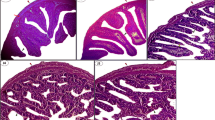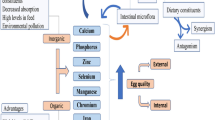Abstract
This study was conducted to investigate the effect of different supplementation levels of Chlorella microalgae on serum metabolites and the plasma content of minerals in laying hens reared under heat stress condition (27.5–36.7 °C, variable). A total number of 378 (40 weeks of age, with mean body weight of 1390 ± 120 g) were randomly allocated to six treatments with seven replicates. The birds were randomly assigned to 6 treatments (C, T1, T2, T3, T4, and T5) with 7 replicate cages of 9 birds. C. microalgae at the rates of 100, 200, 300, 400, and 500 ppm with water were offered to groups T1, T2, T3, T4, and T5, respectively, while group C served as a control. At 71 days of trial, blood samples (14 samples per treatment) were taken for measuring serum metabolites and at 72 days for plasma mineral analysis. The results of this experiment showed that the supplementation of 200–500 ppm C. microalgae decreased the serum content of cholesterol, triglycerides, and LDL (P < 0.05) whereas HDL content increased (P < 0.05) in the hens supplemented with C. microalgae (300 or 400 and 500 ppm). C. microalgae at rates of 300–500 ppm caused a marked (P < 0.05) increase in the plasma content of manganese or iodine and selenium but other minerals were not statistically different among treatments. Overall, from the results of the present experiment, it can be concluded that supplementation of C. microalgae at high rates was beneficial on blood parameters of laying hens reared under heat stress.
Similar content being viewed by others
References
An HJ, Rim HK, Lee HJ et al (2008) Effect of Chlorella vulgaris on immune-enhancement and cytokine production in vivo and in vitro. Food Sci Biotechnol 17:953–958
Azad MAK, Kikusato M, Maekawa T, Shirakawa H, Toyomizu M (2010) Metabolic characteristics and oxidative damage to skeletal muscle in broiler chickens exposed to chronic heat stress. Comp Biochem Physiol Part A 155:401–406. doi:10.1016/j.cbpa.2009.12.011
Becker W (2004) Microalgae in human and animal nutrition. In: Richmond A (ed) Handbook of microalga culture. Blackwell, Oxford pp, pp 312–351
Borowitzka MA (1988) Vitamins and fine chemicals from micro-algae. In: Micro-algal biotechnology. Edited by Borowitzka LJ. New York: Cambridge University Press 153
Brown MR, Jeffrey SW, Volkman JK, Dunstan GA (1997) Nutritional properties of microalgae for Mari culture. Aquaculture 151:315–331
Cornet JF (1998) Le technoscope: les photobioréacteurs. Biofutur 176:1–10
Ghazi S, Habibiyan M, Moeini MM, Abdolmohammadi AR (2012) Effects of dietary selenium, vitamin E, and their combination on growth, serum metabolites, and antioxidant defense system in skeletal muscle of broilers under heat stress. Biol Trace Elem Res 148:322–330. doi:10.1007/s12011-012-9374-0
Ginzberg A, Cohen M, Sod-Mariah UA, Shany S, Rosenshtrauch A, Arad S (2000) Chickens fed with biomass of the red microalga Porphyridium sp. have reduced blood cholesterol level and modified fatty acid composition in egg yolk. J App phycol 12:325–330
Habibian M, Ghazi S, Moeini M, Abdolmohammadi AR (2014) Effects of dietary selenium and vitamin E on immune response and biological blood parameters of broilers reared under thermo neutral or heat stress conditions. Int J Biometeorol 58:741–752. doi:10.1007/s00484-013-0654-y
Halliwell B, Gutteridge JMC (1989) Free radicals. In: biology and medicine, 2nd ed, Oxford University Press, New York, pp 103–112
Lohman LSL-Classic International (2011) Variety LSL-Lite commercial management guide. Lohman International, Tierzucht. www.Itz.de
Merchant RE, Andre CA (2001) A review of recent clinical trials of the nutritional supplement Chlorella pyrenoidosa in the treatment of fibromyalgia, hypertension, and ulcerative colitis. Altern Therap 7(3):79–90
Moradi Kor N, Mohamadi N (2015) The effects of different levels Chlorella microalgae on performance and immune response of laying hens under heat stress condition. Int J Life Sci 9(2):71–74. doi:10.3126/ijls.v9i2.12058
Mujahid A, Yoshiki Y, Akiba Y, Toyomizu M (2005) Superoxide radical production in chicken skeletal muscle induced by acute heat stress. Poult Sci 84:307–314
Mujahid A, Pumford NR, Bottje W, Nakagawa K, Miyazawa T, Akiba Y, Toyomizu M (2007) Mitochondrial oxidative damage in chicken skeletal muscle induced by acute heat stress. J Poult Sci 44:439–445
Muller-Feuga A (2000) The role of microalgae in aquaculture: situation and trends. J Appl Physiol 12:527–534
Neu HC (1992) The crisis in antibiotic resistance. Science 257:1064–1073
Okudo M, Hasegawa T, Sonoda M, Okabe T, Tanaka M (1975) The effects of Chlorella on the level of cholesterol in serum and liver. Jpn J Nutr 33:3–8
Onderci M, Sahin N, Sahin K, Kilic N (2003) Antioxidant properties of chromium and zinc. Biol Trace Elem Res 92:139–149
Queiroz ML, Bincoletto C, Valadares MC, Dantas DC, Santos LM (2002) Effects of Chlorella vulgaris extract on cytokines production in Listeria monocytogenes infected mice. Immunopharmacol Immunotoxicol 24:483–496
Ravagnolo O, Misztal I, Hoogenboom G (2000) Genetic component of heat stress in dairy cattle, development of heat index function. J Dairy Sci 83:2120–2125
Ryll et al (2003) Abstr. Eur Workshop, Microalgal Biotechnol. Germany pp. 56
Sahin K, Kucuk O, Sahin N (2001) Effects of dietary chromium picolinate supplementation on egg production, egg quality, and serum concentrations of insulin, corticosterone and some metabolites of Japanese quails. Nutr Res 21:1315–1321
Sahin K, Sahin N, Onderci M, Gursu F, Cikim G (2002a) Optimal dietary concentration of chromium for alleviating the effect of heat stress on growth, carcass qualities and some serum metabolites of broiler chickens. Biol Trace Elem Res 89:53–64
Sahin K, Sahin N, Yaralioglu S (2002b) Effects of vitamin C and vitamin E on lipid per-oxidation, blood serum metabolites and mineral concentrations of laying hens reared at high ambient temperature. Biol Trace Elem Res 85:35–45
Sahin N, Onderci M, Sahin K (2002c) Effects of dietary chromium and zinc on egg production, egg quality and some blood metabolites of laying hens reared under low ambient temperature. Biol Trace Elem Res 85:47–58
SAS software (2001) SAS user’s guide: statistics, version 9.2, SAS Institute, North Carolina, USA
Schubert LE (1988) The use of spirulina and chlorella as food resource for animals and humans. In: Progressing physiological research. Edited by Round FE, Chapman DJ. Bristol, U.K.: Biopress Ltd; 23
Skjanes K, Rebours C, Lindblad P (2013) Potential for green microalgae to produce hydrogen, pharmaceuticals and other high value products in a combined process. Critical Rev Biotechnol 33(2):172–215. doi:10.3109/07388551.2012.681625
Smith MO, Teeter RG (1987) Potassium balance of the 5 to 8-week old broiler exposed to constant heat or cycling high temperature stress and the effects of supplemental potassium chloride on body weight gain and feed efficiency. Poult Sci 66:487–492
Spolaore P, Joannis-Cassan C, Duran E, Isambert A (2006) Commercial applications of microalgae. J Biosci Bioengine 101(2):86–96
Tsuchida T, Mashiko K, Yamada K, Hiratsuka H, Shimada T, Itagaki Y, Fujinuma H, Samejima K, Nakamura T, Hasegawa T, Matsubayashi T (2003) Clinical study of gamma-amino butyric acid-rich Chlorella for subjects with high-normal blood pressure and mild hypertension. J Jpn Soc Nutr Food Sci 56:97–102
Xu W, Gao Z, Qi Z, Qiu M, Peng J, Shao R (2014) Effect of dietary chlorella on the growth performance and physiological parameters of Gibel carp, Carassius auratus gibelio. Turk J Fisher Aqua Sci 14:53–57. doi:10.4194/1303-2712-v14_1_07
Yardibi H, Turkay G (2008) The effects of vitamin E on the antioxidant system, egg production and egg quality in heat stressed laying hen. Turk J Vet Anim Sci 32:319–325
Zheng L, Oh ST, Jeon JY, Moon BH, Kwon HS, Lim SU, An BK, Kang CW (2012) The dietary effects of fermented Chlorella vulgaris (CBT) on production performance, liver lipids and intestinal microflora in laying hens. Asian-Aust J Anim Sci 25(2):261–266. doi:10.5713/ajas.2011.11273
Author information
Authors and Affiliations
Corresponding author
Rights and permissions
About this article
Cite this article
Moradi kor, N., Akbari, M. & Olfati, A. The effects of different levels of Chlorella microalgae on blood biochemical parameters and trace mineral concentrations of laying hens reared under heat stress condition. Int J Biometeorol 60, 757–762 (2016). https://doi.org/10.1007/s00484-015-1071-1
Received:
Revised:
Accepted:
Published:
Issue Date:
DOI: https://doi.org/10.1007/s00484-015-1071-1




